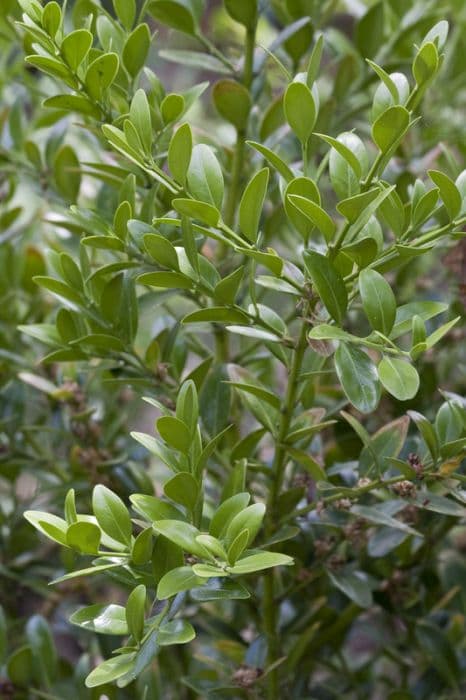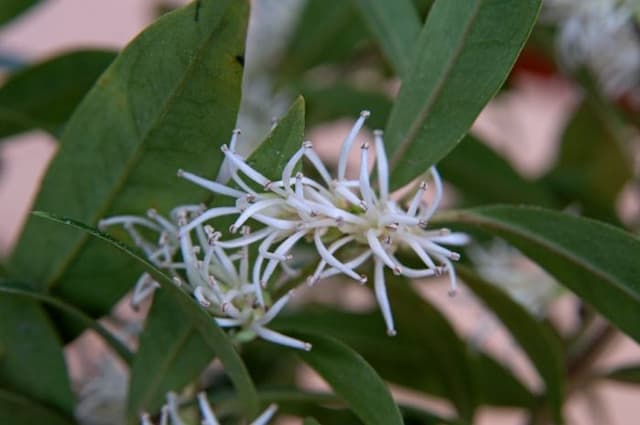Sweetbox Sarcococca ruscifolia

ABOUT
Commonly known as Sweet Box, this evergreen shrub is best recognized for its dense, dark green foliage that maintains its color throughout the year. The leaves are leather-like to the touch, with a glossy finish, and are arranged alternately along the stem. They often possess a sharp point at the tip, elongating into a smooth and slender shape. During the late winter to early spring, Sweet Box produces small and inconspicuous creamy-white flowers. The tiny blossoms are incredibly fragrant, emitting a sweet scent that can be noticeable from a distance, despite their small size. Following the flowering phase, the plant bears glossy red to black berries, which contrast vividly against the deep green leaves and can attract birds. The overall form of Sweet Box is compact and bushy, featuring multiple stems that emerge from the base, providing a lush appearance perfect for shady garden areas or as understory plantings. The textural quality of its foliage, combined with the intensely fragrant flowers and decorative berries, makes this plant an alluring addition to the landscape throughout the year.
About this plant
 Names
NamesSynonyms
Sweet Box, Christmas Box, Fragrant Sarcococca.
Common names
Sarcococca ruscifolia_var._chinensis, Sarcocococca saligna, Sarcococca pruniformis, Sarcococca longifolia, Sarcococca longipetiolata, Sarcococca humilis_var._chinensis.
 Toxicity
ToxicityTo humans
Sweet box is generally considered non-toxic to humans. There are no significant toxic effects reported for accidental ingestion of sweet box.
To pets
Sweet box is also not commonly known to be toxic to pets. It does not typically cause any serious symptoms of poisoning if pets happen to ingest parts of the plant. However, it is always best to prevent pets from eating plants as individual animals might react differently.
 Characteristics
CharacteristicsLife cycle
Perennials
Foliage type
Evergreen
Color of leaves
Dark green
Flower color
White
Height
3-5 feet (0.9-1.5 meters)
Spread
3-5 feet (0.9-1.5 meters)
Plant type
Shrub
Hardiness zones
7
Native area
Himalayas
Benefits
 General Benefits
General Benefits- Aesthetic Appeal: Sarcococca ruscifolia, commonly known as Christmas box, provides year-round visual interest with its glossy green leaves and dense, compact form.
- Fragrant Blossoms: Christmas box produces small but highly fragrant white flowers that can add a pleasant scent to gardens during the late winter months.
- Low Maintenance: It is easy to grow and requires minimal upkeep once established, making it a good choice for gardeners of all skill levels.
- Shade Tolerance: Christmas box thrives in partial to full shade, making it an excellent plant for understory plantings or shaded garden areas where other plants may struggle.
- Drought Resistance: Once established, it is relatively drought-tolerant, reducing the need for frequent watering.
- Erosion Control: Its dense root system can help stabilize soil and prevent erosion on slopes or in other vulnerable areas.
- Wildlife Attraction: The plant's berries attract birds, providing them with a food source and adding to the biodiversity of the garden.
- Year-Round Interest: The evergreen nature of Christmas box ensures that it provides visual interest throughout all seasons, even in the depths of winter.
- Compact Growth: The small stature of Christmas box makes it suitable for use in smaller gardens, borders, or as ground cover without overwhelming the space.
 Medical Properties
Medical PropertiesThis plant is not used for medical purposes.
 Air-purifying Qualities
Air-purifying QualitiesThis plant is not specifically known for air purifying qualities.
 Other Uses
Other Uses- Sweet Box can be used as a natural privacy screen due to its dense foliage and can be pruned to maintain a desired shape or boundary.
- Its ability to thrive in deep shade makes it an ideal ground cover plant for dark and underutilized areas of the garden.
- The plant's tolerance for pollution allows it to be used for urban landscaping, providing greenery in cities with low maintenance.
- Sweet Box works well as a foundational plant in mixed borders, giving year-round structure amidst other perennials and shrubs.
- The plant is sometimes incorporated into sensory gardens for its strong, sweet fragrance that can be enjoyed during the winter.
- Dried Sarcococca ruscifolia foliage can be included in potpourri mixes to add a wintergreen scent to the mixture.
- The wood, being quite hard and dense, has been used on a small scale for crafting turning objects or intricate wood pieces.
- As an evergreen with a neat growth habit, it is often used in formal garden designs to create geometric shapes and borders.
- The long-lasting berries can be used as natural decorations in floral arrangements, adding a touch of red or black amongst flowers.
- The plant's resistance to deer browsing makes it a suitable option for gardens in areas where deer predation is a concern.
Interesting Facts
 Feng Shui
Feng ShuiThe Sweet Box is not used in Feng Shui practice.
 Zodiac Sign Compitability
Zodiac Sign CompitabilityThe Sweet Box is not used in astrology practice.
 Plant Symbolism
Plant Symbolism- Tenacity: Sarcococca ruscifolia, commonly known as 'Sweetbox', has glossy evergreen leaves and a vigorous nature, symbolizing resilience and the ability to endure challenges.
- Protection: Sweetbox, with its dense foliage, has been thought to offer protection, symbolizing safety and shelter.
- Purity: The white fragrant flowers of the Sweetbox represent cleanliness and innocence.
- Secretive Beauty: Since Sweetbox flowers are often hidden beneath the leaves, they can symbolize the hidden beauty and subtle charm that's not immediately obvious.
 Water
WaterFor Sweet Box (Sarcococca ruscifolia), maintain consistently moist soil by watering it when the top inch of soil feels dry to the touch. On average, watering once a week should suffice, but this will vary depending on climate conditions and soil drainage. Use enough water to soak the soil around the roots, which typically equates to approximately 1 gallon for outdoor plants. During the rainy season or in cooler weather, reduce the frequency to prevent waterlogging. Ensure the plant has proper drainage to avoid root rot, and water more frequently during dry spells or hot summers.
 Light
LightSweet Box prefers dappled shade or partial sunlight, avoiding direct afternoon sun which can be too intense. The ideal spot for this plant is in a location that receives filtered morning light or bright, indirect light throughout the day. If indoors, a north-facing window or a position set back from a sunnier window can provide suitable light conditions.
 Temperature
TemperatureSweet Box thrives in a wide range of temperatures and is hardy in USDA zones 7 through 9. Ideally, it prefers temperatures between 60°F and 80°F. The plant can tolerate temperatures as low as 0°F and up to about 90°F but may suffer in extremes beyond this range. Provide protection from harsh winter winds and extreme summer heat to maintain its health and appearance.
 Pruning
PruningSweet Box requires minimal pruning which can be performed to shape the plant or control its size. The best time for pruning is in late winter or early spring before new growth begins. Trim back any unruly branches and remove dead or damaged wood to maintain a tidy appearance. Generally, once a year is enough unless you are creating a hedge or specific shape which may require more frequent pruning.
 Cleaning
CleaningAs needed
 Soil
SoilSweet box thrives in moist, well-draining soil with a pH of 5.5 to 6.5. A good mix would include garden soil, peat moss, and perlite to enhance drainage and maintain slight acidity.
 Repotting
RepottingSweet box rarely needs repotting and is typically repotted every 2-3 years or when it outgrows its container.
 Humidity & Misting
Humidity & MistingSweet box prefers moderate to high humidity levels but is adaptable to a wide range as long as the soil moisture is well maintained.
 Suitable locations
Suitable locationsIndoor
Keep sweet box in bright, indirect light and water when topsoil is dry.
Outdoor
Plant sweet box in partial shade, sheltered from intense sun.
Hardiness zone
7-9 USDA
 Life cycle
Life cycleSarcococca ruscifolia, commonly known as Fragrant Sweetbox, begins its life cycle as a seed, often dispersed by animals or gravity close to the parent plant. After germination, which requires a moist and shaded environment, the seedling emerges and develops into a juvenile plant, gradually forming a dense clump of glossy green leaves. As it matures, Fragrant Sweetbox produces small, unassuming flowers during late winter to early spring, which are highly fragrant and followed by the development of red berries that turn to black upon ripening. These berries contain seeds that can propagate the next generation if they fall to the ground or are carried away by fauna. Throughout its life, this evergreen shrub undergoes periodic vegetative growth, expanding its leafy branches and shallow root system. This plant can live for many years, becoming a stable understory component in suitable woodland or garden settings, requiring minimal maintenance once established.
 Propogation
PropogationPropogation time
Spring
Sarcococca ruscifolia, commonly known as Sweet Box or Christmas Box, prefers to be propagated during the late winter to early spring months. The most popular method of propagation for Sweet Box is through semi-hardwood cuttings. This involves cutting a 4 to 6-inch length of stem that has matured but not become completely woody from the current season's growth. The lower leaves are stripped off, and the cut end can be treated with a rooting hormone to encourage root development. The cutting should then be planted in a pot filled with a moist mixture of peat and perlite, ensuring that the leaf nodes from which you removed the leaves are buried. The pot is covered with plastic to maintain humidity and is kept in indirect light until roots develop, which can take several weeks. It's important to keep the soil moist but not waterlogged during this time. After rooting, the new Sweet Box plant can be transferred to a larger pot or directly into the garden.






![Sweet box [Winter Gem]](/_next/image?url=https%3A%2F%2Fplants-admin.emdemapps.com%2Fimages%2Fplants%2F%2Fimages%2F604b6267b442c.png&w=640&q=75)


